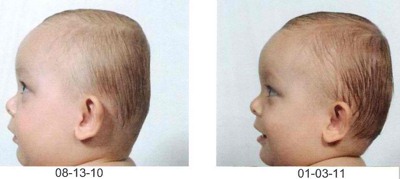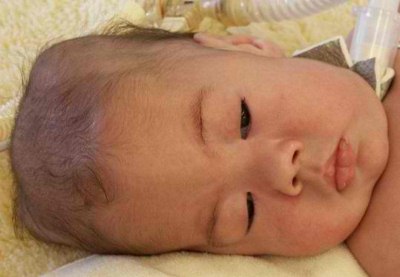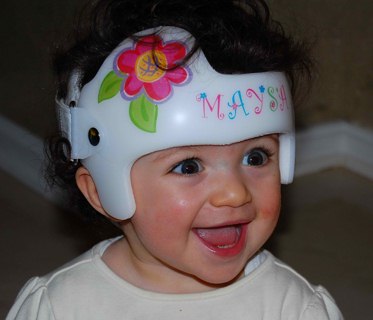Plagiocephaly – Treatment, Positional, Helmet, Symptoms, Pictures
What is Plagiocephaly?
Plagiocephaly is a structural deformity of the skull characterized by asymmetry of the head. The term specifically describes a flattening of the head to one side or at the back and sometimes associated with facial asymmetry. It is also termed as a “flat head syndrome”.
Plagiocephaly can be present at birth or develops during the early months of life. The most common form of plagiocephaly nowadays is flattening at the back because of sleeping patterns as a result of repeated pressure in a particular side or part.
what causes flat head syndrome?
Plagiocephaly should not be seen as an abnormal condition because it is normal for a newborn’s head to have flattening because of the soft skull. Plagiocephaly at the time of birth may be resolved in two months. However, the baby’s head may continuously be flattened because of external factors such as positioning during sleep.
Flattening of the head is very common among infants and should not cause alarm to parents because this does not mean any medical implications.
Plagiocephaly occurs because the sutures in the baby’s skull have not fused yet. The skull remains to be malleable and soft. Premature infants are more prone to plagiocephaly because they have softer skulls than term newborns and they are confined to the hospital longer for further management.
Plagiocephaly is different from craniosynostosis, which is a more serious skull malformation. Craniosynosotosis results from premature fusing of the sutures in the skull which makes the head deformed. Craniosynostosis should be ruled out because it requires more extensive management.

Plagiocephaly Image
Plagiocephaly Types
Plagiocephaly has several types depending on the location of the flattening. These include:
1. Positional Plagiocephaly
Positional or deformational plagiocephaly is the flattening of the skull as a result of positioning the baby’s head to one side only. This may occur due to crowding inside the uterus that results to flattening or letting the infant lie in the same position for prolonged periods.
Positional plagiocephaly may be present as a flattening of the occipital or frontal areas of the skull and may cause facial asymmetry which can also be resolved during the baby’s head development.

Positional Plagiocephaly
2. Brachycephaly
Brachycephaly is a flattening of the whole back of the skull. This result in a very wide head shape that appears wider compared to its height. The forehead may also be prominent to compensate with the flattening of the back of the head.

Brachycephaly Image
3. Scaphocephaly or Dolichoceophaly
These conditions occur when the head is longer in relation to its height. These usually result from lying to one side for prolonged periods as seen in preterm babies in the neonatal intensive care unit. Side lying position allows for easy access of the neonate for feeding or monitoring purposes.

Dolichoceophaly Image
Plagiocephaly Causes
Plagiocephaly results mainly from positional factors. Plagiocephaly develops as a result of resistance or pressure on the soft skull. This can happen inside the uterus or may develop as the child grows. The most common causes of plagiocephaly include:
Restrictive intrauterine environment
Pressure inside the uterus resulting from other fetal structures such as the placenta causes the head of the fetus to flatten even when the baby is still inside the womb. Plagiocephaly becomes apparent at birth and resolves within two months.
Letting the baby lie in a certain position for prolonged periods
When babies lie on their backs all the time, it causes flattening of the occipital area because of constant pressure on the area. There has been an increase in flat head syndrome as a result of recommendations to keep babies lie on their back to prevent sudden infant death syndrome. Side lying for prolonged periods also makes the baby’s head flat on a particular side. This can also be seen in babies who are always on car seats, bouncy seats and carriers.
Torticollis
Torticollis or rye neck is the twisting of the neck which tilts the head to one side. This prevents the baby to turn their head because of neck pain. As a result, the baby assumes a certain position to prevent pain. Torticollis should be managed by physiotherapist because it causes considerable pain and may impair the breathing of the baby.

Torticollis as a cause of Plagiocephaly
Too little “cuddle time”
Letting the baby lie most of the time increases the risk for flat head. Caregivers should ensure to cuddle their babies once in a while to prevent plagiocephaly and improve bonding with the child.
Plagiocephaly Treatment
Plagiocephaly often do not need treatment because it can be resolved as the baby grows. However, treatments are also useful to improve the shape of the baby’s head and reduce anxiety of parents. Management for plagiocephaly focuses on preventing pressure on a particular part of the baby’s head. More serious cases may need corrective devices. These managements include:
Repositioning or Counter Positioning
Reposition the baby’s head during sleeping to prevent pressure at the back or at the sides. Avoid prolonged use of car seats and carriers, instead, cuddle the baby. Watch out for signs of torticollis such as crying when the baby’s head is moved to prevent further injury and pain.
Stimulate the baby to look at the opposite side of the flattening by using stimulating toys such as a big red balloon. Repositioning the baby’s head from time to time allows pressure on all areas of the skull and prevents flattening.
Cranial Remolding Orthosis or “baby helmet”
This device helps correct the abnormal head shape of babies by allowing the head to be contoured appropriately. The device is often used when repositioning does not improve the condition. It is also used in cases of positional plagiocephaly, scaphocephaly and brachycephaly. It is often prescribed for babies three to 18 months of age wherein the skull is still soft and can be remolded.
- The cranial remolding orthosis provides pressure on the side that is more prominent and leaves a space on the other side to allow the head to be shaped normally.
- Cranial remolding orthotics is light weight and made from a thin, hard shell lined with foam. It is worn 23 hours a day for maximum results. It can be taken off when the baby bathes. It is also readjusted from time to time by health care providers.
- The use of cranial remolding orthosis is painless and takes three to four months to use the device. It has been effective in treating flat head syndrome over the years.
- Parents should be instructed that this device is only temporary and has excellent outcomes.

Cranial Remolding Orthosis to treat Plagiocephaly
Custom Head Bands
Head bands provide a minimal amount of pressure on the baby’s head that needs reshaping. The band is usually provided and adjusted by pediatricians from time to time. It is more comfortable than the baby helmets, but is also prescribed for milder cases of plagiocephaly. Certain commercial head bands are also available for baby’s use. Regular head bands should not be used because it offers no relief from flattening of the head.
Presence of craniosynostosis is more severe and requires surgical management and advanced orthotics to correct the deformity. Fortunately, plagiocephaly does not require such.

Custom Head Bands to treat Plagiocephaly
Plagiocephaly Prevention
How are we going to prevent plagiocephaly? Preventing the occurrence of “flat head syndrome” entails preventing too much pressure on a certain part of the head. These measures include:
- Vary the baby’s position during sleeping time from flat, right side lying and left side lying position.
- Try to change the position of the baby crib to prevent the baby from looking at certain things that keep their head to one position most of the time.
- Reposition the baby in the crib such as changing the direction where his/her feet point to. This will also prevent the baby from positioning the head on certain areas because of constantly looking at a particular object in the room.
- Place the baby on their tummy during playtime to prevent pressure on their soft head. This can be done four times a day.
- Carry your baby from time to time to enhance bonding and prevent plagiocephaly.
- Be sure not to put the bay in prone position or on his/her tummy during sleeping. Tummy time prevents plagiocephaly, but positioning in this way during sleeping may lead to suffocation and sudden infant death syndrome.
- Avoid letting the baby sleep for prolonged periods in car seats and carriers.
Prognosis
Early studies have indicated that plagiocephaly results in learning difficulties and neurosensory problems. However, these studies have not been validated and experts now suggest that plagicephaly does not result to such. In fact, plagiocephaly do not lead to serious health problems.
The head deformity may be untreated because it usually resolves as the baby grows. Treatments discussed earlier are effective in managing plagiocephaly. Plagiocephaly does not need invasive surgical procedures to correct the deformity of the head.
Prognosis is excellent and most of the cases were naturally resolved before the baby’s first birthday.
Complications
Plagiocephaly does not result in complications aside from the lasting effect on the baby’s head. Plagiocephaly does not result in neurologic disorders or abnormalities in the baby’s brain development as well as sensory development. Facial asymmetry that results from plagiocephaly also resolves as the child grows.